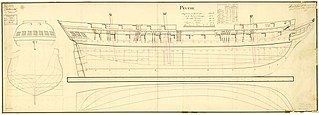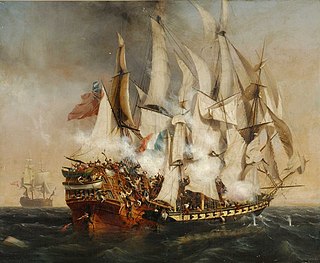
HMS Astraea was a 32-gun fifth rate Active-class frigate of the Royal Navy. Fabian at E. Cowes launched her in 1781, and she saw action in the American War of Independence as well as during the Napoleonic Wars. She is best known for her capture of the larger French frigate Gloire in a battle on 10 April 1795, while under the command of Captain Lord Henry Paulet. She was wrecked on 23 March 1808 off the coast of Anegada in the British Virgin Islands.

HMS Culloden was a 74-gun third rate ship of the line of the Royal Navy, launched on 16 June 1783 at Rotherhithe. She took part in some of the most famous battles of the French Revolutionary Wars and the Napoleonic Wars before she was broken up in 1813.
Gloire, meaning "glory", has been a popular name for French vessels.

HMS Thames was a 32-gun Richmond-class fifth-rate frigate of the Royal Navy built by Henry Adams and launched at Bucklers Hard in 1758. She served in several wars, including for some four years in French service after her capture. She was recaptured in 1796 and was broken up in 1803.

Sibylle was a 38-gun Hébé-class frigate of the French Navy. She was launched in 1791 at the dockyards in Toulon and placed in service in 1792. After the 50-gun fourth rate HMS Romney captured her in 1794, the British took her into service as HMS Sybille. She served in the Royal Navy until disposed of in 1833. While in British service, Sybille participated in three notable single-ship actions, in each case capturing a French vessel. On anti-slavery duties off West Africa from July 1827 to June 1830, Sybille captured many slavers and freed some 3,500 slaves. She was finally sold in 1833 in Portsmouth.

Psyché was a 36-gun vessel built between February 1798 and 1799 at Basse-Indre (Nantes) as a privateer. As a privateer she had an inconclusive but bloody encounter with HMS Wilhelmina of the Royal Navy, commanded by Commander Henry Lambert, off the Indian coast in April 1804. The French then brought her into service in June 1804 as the frigate Psyché. In February 1805 she encountered HMS St Fiorenzo, under the command of the same Henry Lambert, now an acting captain. After a sanguinary engagement of over three hours, Psyché surrendered. The British took her into service as HMS Psyche. In British service she captured several prizes and took part in the capture of Mauritius and in an operation in Java. She was broken up at Ferrol in 1812.

The French frigate Aigle was launched in 1780 as a privateer. The French Navy purchased her in 1782, but the British captured her that same year and took her into the Royal Navy as the 38-gun fifth rate HMS Aigle. During the French Revolutionary Wars she served primarily in the Mediterranean, where she was wrecked in 1798.

Bellone was a French privateer frigate that cruised under Jacques François Perroud and achieved fame with the capture of large East Indiaman Lord Nelson on 14 August 1803. HMS Powerful captured her during the action of 9 July 1806. The British Royal Navy took her into service as HMS Bellona. Later, the Navy renamed her HMS Blanche. She was broken up in 1814.

Confiance, launched in 1797, was a privateer corvette from Bordeaux, famous for being Robert Surcouf's ship during the capture of the British East India Company's East Indiaman Kent. The British Royal Navy captured Confiance in 1805, took her into service under her existing name, and sold her in 1810. Before she was sold, Confiance took part in two notable actions.
Émilie a French corvette-built privateer based in Île de France. She is mostly known as one of the ships captained by Robert Surcouf.
Henriette was a French privateer commissioned in Bordeaux in late 1803. She served in the Bay of Biscay until mid-1804, and then in the Indian Ocean, based at Île de France. The 74-gun HMS Powerful captured her in June 1806 off Ceylon.
Adèle was a French privateer brig commissioned in 1800 that the British Royal Navy captured later that year. The British East India Company's government in India purchased her in 1801 for service as an armed brig in the Bay of Bengal and along the Coromandel Coast. In 1804 she sailed to Britain where the Admiralty purchased her for use as a fire ship, and named her HMS Firebrand. She was wrecked in 1804.
Diamond was launched in 1798 at Quebec. French privateers captured her three times, the third time retaining her. In between she sailed as a slave ship in the triangular trade in enslaved people. Her third capture occurred while she was on a whaling voyage. Her last voyage took her from Île de France to Bordeaux where she was decommissioned in January 1809.
Numerous French privateers have borne the name Vengeur ("Avenger"):
Eliza Ann was launched at Calcutta in 1795. She sailed to England where she was admitted to the Registry. In all, she made five voyages for the British East India Company (EIC), during one of which she participated in a notable action and during the last of which she captured a French privateer. She herself was lost in 1807.
Huron, of Bordeaux, was commissioned in 1793 as a privateer. She made several cruises before the British Royal Navy captured her in 1801 as she was returning to France with cargo from Mauritius. She was sold and then proceeded to sail between England and America as a merchantman. She was last listed in 1808.
General Augereau was a ketch launched in 1801 and recommissioned in Bayonne in 1803 as a privateer. She made a small number of captures during her first cruise, but then the British Royal Navy captured her in February 1805 during her second cruise. She became a British merchantman, sailing between Cork and Liverpool, and was last listed in 1813.
HMS Favorite was an 18-gun Cormorant-class ship-sloop, launched in 1806 and broken up in 1821. In her career she sailed as far North America, the Caribbean, Africa, South America, and the Far East. She captured or recaptured several merchant ships and a handful of privateers.

HMS Albatross was the name vessel of her class of brig-sloops. She was built of fir and launched in 1796. She captured two privateers in the North Sea. She then sailed to the Far East. There she captured two French privateers in single-ship actions. She was sold in the Far East in 1807 and broken up in 1810.








